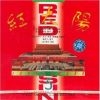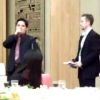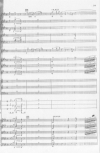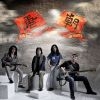 ill. 2.11 a, metadata
ill. 2.11 a, metadata
 ill. 2.11 b, metadata
ill. 2.11 b, metadata
 ill. 2.11 c, metadata
ill. 2.11 c, metadata
 ill. 2.11 d, metadata
ill. 2.11 d, metadata
 ill. 2.12, metadata
ill. 2.12, metadata
Tan Dun Red Forecast, part 3
Tan Dun’s “Red Forecast” ends with idyllic sounds in the woodwinds, and with a stage “washed in red.” Tan Dun thus repeats exactly the typical final apotheosis as found in the model works of the Cultural Revolution: they invariably end with spheric sounds, a tableau of heroes and a stage all washed in red as can be seen here.
Is Tan Dun’s ending then—similar to what we can find in some of the photographic backgrounds offered to Chinese parents for effective pictures of their “little heroes,” at tourist places (ill. 2.12)—a carnivalization of the Cultural Revolution and its cultural aesthetics? In the case of Tan Dun, the immediate answer to the question is: “No.” According to the composer, the last movement of his composition is a lovesong to nature and the future. The colour red symbolizes for Tan Dun change, revolution and passion. In his view, the work ends in a transcendent and optimistic mode. Musically, this makes sense, as the last few bars are a recapitulation of the dance motif from earlier movements, and, even more significantly, the composition ends as it begins, the first word in the composition is “sun” and it ends in sunshine, too (cf. Gooi 2001:167).
The work’s enigmatic title Red Forecast is to be read, in Tan’s own interpretation, as follows: the forecast for mankind in the future is a retrieval of lost ideals and passions, symbolized by the color red. There is certainty to his conviction; it is a forecast, a prediction indeed. Tan Dun shows himself convinced that in the new millennium humankind will be able to regain its idealism and spiritual powers. This cannot be achieved, as Tan Dun insists, by simply being nostalgic for past ideals—a nostalgia he observes as on the rise in his own country. Only a serious and honest engagement—so the composition seems to suggest—with the positive as well as the negative sides of this revolutionary past will make such a future scenario possible: learning a lesson from history.
Red Forecast demands such serious engagement with the past from its audience. As a multimedia work, it bears many similarities to the model works from the Cultural Revolution—in its use of color symbolism, in its employment of telltale melodies from revolutionary songs, in its use of artistic repetition for semantic effect. But at the same time Red Forecast could not be more different from the model works. For when the model works combine music, text, gestures, costumes, setting, and lighting they do so in order to repeat the same message, such as “this is a bad character” or “this is the main hero,” over and over again on many different levels of signification in order to make sure that the audience understands it on at least one of these levels. In Tan Dun’s composition, on the other hand, the different levels say and mean many different and often contradictory things. Multiple levels are thus not used as they were during the Cultural Revolution to reinforce the one and only one message, that of people’s love for and belief in Mao and the Communist victory.
Quite on the contrary, multiple levels serve in Tan Dun’s composition to magnify contradictions between multiple messages, which might be comprehensible when taken one by one but which become all the more impossible to decipher in combination. Thus, it is possible to see irony and doubt in the antagonistic juxtapositions of music, pictures, and effects of light and color, as well as in the false connections between and constant dismantlings of political songs such as “We Shall Overcome” and “Red Is the East.” This is so even as the composer appears to negate this interpretation when he calls “red” the color of hope and thus mimics, literally, the rhetoric associated with this color during the Cultural Revolution.



































